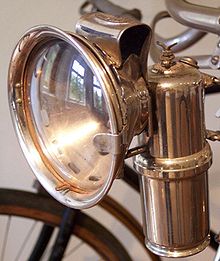| Revision as of 20:58, 19 November 2005 editSCEhardt (talk | contribs)Extended confirmed users15,691 edits + photo← Previous edit | Revision as of 19:47, 16 January 2006 edit undo24.98.33.237 (talk)No edit summaryNext edit → | ||
| Line 5: | Line 5: | ||
| These lamps were formerly found in mines (not to be confused with the ]), vintage ], and ]s; they are still sometimes used by ]s. | These lamps were formerly found in mines (not to be confused with the ]), vintage ], and ]s; they are still sometimes used by ]s. | ||
| Pellets or chunks of calcium carbide (CaC<sub>2</sub>) are placed in a chamber (the generator). A second chamber is filled with water. A screw valve or another mechanism is used to control the rate at which the water is allowed to drip into the chamber containing the calcium carbide. By controlling the amount of acetylene gas, the user |
Pellets or chunks of calcium carbide (CaC<sub>2</sub>) are placed in a chamber (the generator). A second chamber is filled with water. A screw valve or another mechanism is used to control the rate at which the water is allowed to drip into the chamber containing the calcium carbide. By controlling the amount of acetylene gas, the user controls the size of the flame (and thus the amount of light it produces). | ||
| The carbide lamp generally has a reflector behind the flame to redirect light in a more useful direction. A carbide lamp produces a surprisingly bright, broad light. Many cavers prefer this type of unfocused light as it improves peripheral vision in the completely dark environment. | The carbide lamp generally has a reflector behind the flame to redirect light in a more useful direction. A carbide lamp produces a surprisingly bright, broad light. Many cavers prefer this type of unfocused light as it improves peripheral vision in the completely dark environment. | ||
Revision as of 19:47, 16 January 2006

Carbide lamps (acetylene lamps) are simple lamps that produce and burn acetylene gas by reacting calcium carbide with water.
These lamps were formerly found in mines (not to be confused with the Davy lamp), vintage cars, and lighthouses; they are still sometimes used by cavers.
Pellets or chunks of calcium carbide (CaC2) are placed in a chamber (the generator). A second chamber is filled with water. A screw valve or another mechanism is used to control the rate at which the water is allowed to drip into the chamber containing the calcium carbide. By controlling the amount of acetylene gas, the user controls the size of the flame (and thus the amount of light it produces).
The carbide lamp generally has a reflector behind the flame to redirect light in a more useful direction. A carbide lamp produces a surprisingly bright, broad light. Many cavers prefer this type of unfocused light as it improves peripheral vision in the completely dark environment.
The reaction of calcium carbide with water produces a fair amount of heat independent of the flame. In cold cave environments, carbide lamp users can use this heat to help stave off hypothermia.
When all of the carbide in a lamp has been reacted, the carbide chamber contains a wet paste of lime. This is emptied into a waste bag and the chamber can be refilled.
The design of the lamp was first patented in Duluth, Minnesota on October 21, 1902 (U.S. patent 711,871).
| Lighting | |||||||||||||
|---|---|---|---|---|---|---|---|---|---|---|---|---|---|
| Concepts | |||||||||||||
| Methods of generation |
| ||||||||||||
| Stationary | |||||||||||||
| Portable | |||||||||||||
| Automotive | |||||||||||||
| |||||||||||||
| |||||||||||||
| |||||||||||||
| Related topics | |||||||||||||
This technology-related article is a stub. You can help Misplaced Pages by expanding it. |